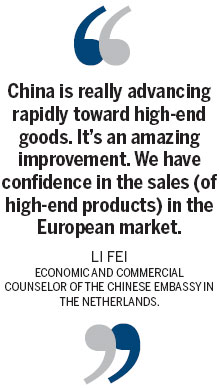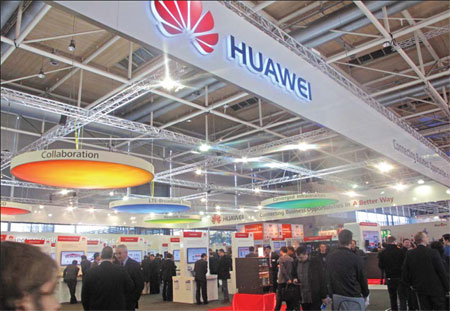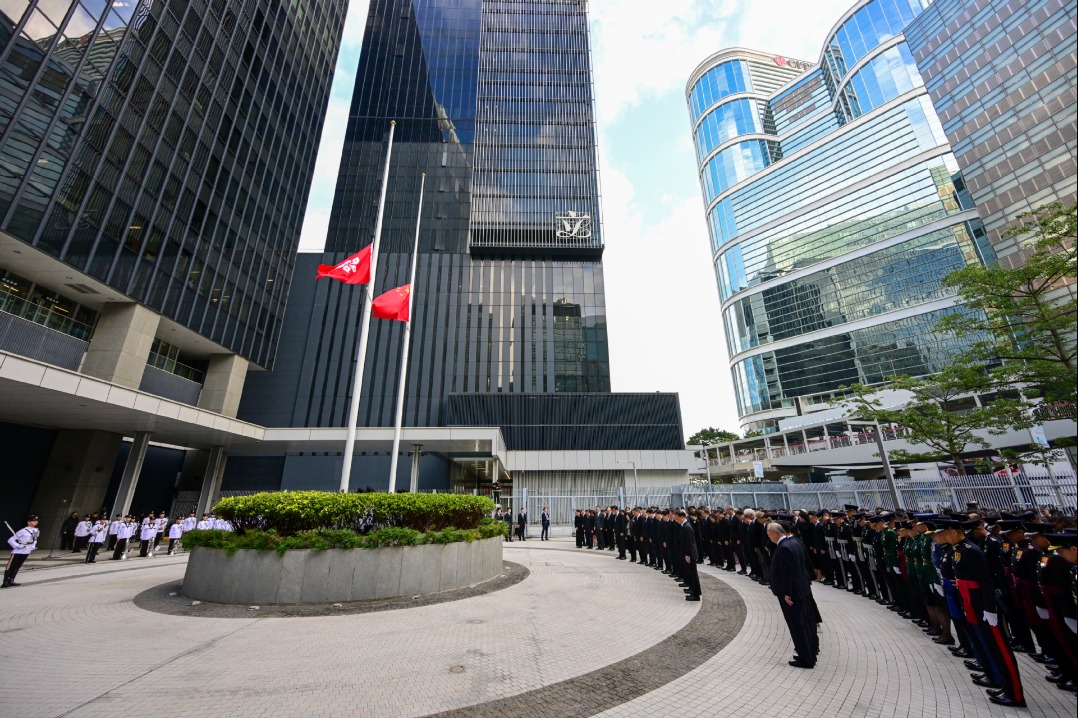The big boys' club

| Some Chinese companies, such as Huawei Technologies Co Ltd, have won international recognition for their know-how. Wang Shiyi / for China Daily |

Chinese companies challenge their Western counterparts by catching up in the field of technology
In his 20-square-meter office in the Oxford University Hospitals NHS Trust in London, Wu Feng, a professor of surgery, receives many patients with different types of tumors every day.
"I am proud of my job, which also offers me the opportunity to show people how excellent made-in-China medical devices are", Wu says, referring to the huge, tumor-treating medical devices. The devices are produced by Chongqing-based Haifu Medical Technology Co Ltd.
"The hospitals introduced the HIFU machine in early 2002, and at that time, the British doctors and professors were surprised that Chinese companies were capable of making such high-end machines, some of which were considered years ahead of their European counterparts," Wu says.
Currently, nine European countries, including Italy, are using 23 HIFU machines.
For years, China has had the image of being a low-cost workshop where quality is inferior and ideas are always copied - or stolen - from the West.
While the Chinese government assists domestic companies on innovation, companies like HIFU are gradually shifting the global preconception.
As global demand shrinks due to the financial crisis, growth of the world's second-largest economy's exports has been declining as well. In 2012, the nation's exports rose by 7.9 percent from a year earlier to $2.05 trillion, the lowest growth in a decade, compared with a 20.3 percent jump in 2011.
But that does nothing to detract from the country's progress on the world stage. An encouraging sign is that some Chinese companies, led by Huawei Technologies Co Ltd and Lenovo Group Ltd, have won international recognition for their know-how.
In 2009, China surpassed Germany as the largest exporter worldwide, and has maintained its position since then.
In 2011, China overtook the United States as the world's biggest goods producer by output, which helped the nation reclaim the global supremacy it lost in the 19th century.
Although China's exports to the EU dropped by 6.2 percent last year, the nation's share in the EU's market for foreign trade rose, experts say.
During the past two to three years, a growing number of Chinese companies have stepped up to acquire Western rivals, those in Europe in particular, to obtain technology and networks, illustrated by Sany Group Co Ltd's purchase of Putzmeister in Germany.
In 2011, China's outbound direct investment in the non-financial sector in the EU increased by 94 percent year-on-year compared with just 1.8 percent growth of total ODI that year.
"China is really advancing rapidly toward high-end goods. It's an amazing improvement. We have confidence in the sales (of high-end products) in the European market," says Li Fei, economic and commercial counselor of the Chinese Embassy in the Netherlands.
In 2011, China surpassed Germany and the US to become the largest source of high-tech products imported by the Netherlands, a barometer of the European economy.
China was expected to lead the trend and maintain the top position in 2012 and beyond, Li predicts.
"Chinese manufacturers can compete with European players in sectors like machinery equipment, new energy and aerospace, but in many industrial sectors and traditional industries, China's design, technology and branding are still weak," says Zhou Shijian, a senior trade expert at Tsinghua University in Beijing.
Examples of competitive Chinese companies are not rare. The Warren Buffett-backed Chinese battery and carmaker BYD Co Ltd, which entered the European market in early 1999 by selling batteries, began to crack the high-end business of electric buses in recent years.
"The European market is the key to our success, and we expect to win the European market through our high-end products," says Chen Yongping, European senior manager at BYD.
The company is well on the way. In January 2012, BYD beat two European counterparts from the United Kingdom and the Netherlands to win an order of six electric buses from the Dutch government.
It was the first electric-bus order the company has got overseas, and also the first order that the European market had ever had.
In October, BYD secured another order of 50 electric cars from London cab service provider Green Tomato Cars.
The company recently gained EU approval to sell its electric buses in all EU member states.
"Renewable energy is what Europe puts emphasis on, and electric buses will lead the trend," said Chen.
"We are glad to see that BYD is four to five years ahead of European products in the sector, thanks to research and development," he added.
Long way to go
Despite the progress that China has made in the past 20 years to lift its reputation as a global manufacturer, many executives and industrial insiders still believe China has a long way to go before it could be at the forefront of high-technology innovation.
"Made-in-China goods will eventually become the gold standard worldwide. It's a matter of time," says Chen Yongwu, general manager of Zoje Europe GmbH.
But "for the time being, there is time for Chinese manufacturers to catch up with their peers in Europe, and Germany in particular, in high-end and value-added goods", he says.
For example, Zhejiang-based Zoje Sewing Machine Co Ltd, the world's leading industrial sewing-machine maker, made two acquisitions in Germany in a bid to improve its technology.
Echoing Chen Yongyu, Tan Zuozhou, president of LiuGong Poland, says: "There is room for us to improve in terms of technology compared with the top industrial brands in Europe. We also have a lot to do in branding."
Guangxi LiuGong Machinery, a Nanning-based Chinese building equipment maker, set up its European headquarters in Poland by acquiring a local counterpart in the eastern European country in early 2012.
For Sander Gesink, marketing manager of LiuGong Machinery Europe BV, "it's not about products only, but more about brand".
Gesink, who has been in the European industry for more than 10 years, says: "LiuGong is a new brand in the EU, and there are challenges to build the brand here. The biggest is the perception of the Chinese brand ... People don't think the Chinese brand is good and worth buying."
For many Chinese brands like LiuGong, another big obstacle is the stigma attached to the "made-in-China" label, which is traditionally associated with sweatshop labor and cheap products.
According to Li Minyan, managing director and chairman of China Certification & Inspection Group Europe BV: "Many Chinese manufacturers are not inferior to their Western rivals in technology and design, but unfortunately, a majority of them lack global recognition. "They need to accelerate their efforts in branding and marketing to raise their awareness. It is time-consuming," she says.
Narrowing gap
Despite the gap, Chinese brands are strongly motivated to improve and compete on the same level as the top global industrial players.
"China is well on its way. But it could take 20 to 30 years for the nation to become a globally well-known manufacturer like Germany," says Wang Weidong, commercial counselor of Chinese Consulate-General in Frankfurt.
"China needs to join hands with European counterparts through mergers and acquisitions and learn from them," he says.
A slew of Chinese companies, including Sany, Xuzhou Construction Machinery Group and Hebei Lingyun, have invested in extending their reach in Europe and they hope to absorb new technologies by recruiting German engineers and getting closer to more customers around the continent.
"We get more technical ideas from our counterparts, and they can expand sales in China and Asia. It's win-win deal," says Chen from Zoje.
As sagging global demand hurts Chinese exports, the Chinese government has repeatedly promised to encourage domestic manufacturers to improve technology and make investments on design and innovation.
In China, there are a number of manufacturers who have a list of clients that enjoy a worldwide reputation, and now, many of them have decided to work on their own brands to target high-end customers.
Bosideng Corp is one of them. The world's largest downcoat manufacturer has been an OEM for various famous foreign fashion brands, about which Zhu Wei, CEO of Bosideng Corp UK, declined to elaborate.
"It's not a small business, worth 140 million yuan ($22.47 million, 17.28 million euros) annually, but the problem is the Bosideng brand is quite new globally, especially in the European market," Zhu says.
In July, the company announced plans to open a three-story menswear store in the busiest commercial area in London, its first-ever store abroad. The store targets high-end customers.
And Bosideng has other ambitious overseas expansion plans. It intends to expand into high-end shopping malls in London, probably early this year, and it is also in talks with some European counterparts, probably from Italy, on acquisition deals.
"Numerous Chinese manufacturers don't have strong brands abroad, and they have to work for others as OEMs, reaping tiny profits. They need to change the situation with the help of think tanks," says David Feng, special assistant to the president of the Aigo Entrepreneurs Alliance.
The alliance, which was set up in 2011, aims to help Chinese companies expand overseas, establish sales networks, conduct market investigations and promote brands. "We have assisted more than 20 domestic companies, and in 2013, that number will be 50 to 100," Feng says.
dingqingfen@chinadaily.com.cn
(China Daily 03/15/2013 page18)
Today's Top News
- Xi stresses improving long-term mechanisms for cyberspace governance
- Experts share ideas on advancing human rights
- Japan PM's remarks on Taiwan send severely wrong signal
- Key steps to boost RMB's intl standing highlighted
- Sustained fight against corruption urged
- Xi calls for promotion of spirit of volunteerism































